Naqlun (Egypt)
NAQLUN 2012: interim report from excavations at the monastery of Nekloni in Fayum
Dates: 1–26 September 2012
Team:
Prof. Dr. Włodzimierz Godlewski, director (Institute of Archaeology, University of Warsaw)
Dr. Dorota Dzierzbicka, archaeologist (Institute for the Study of the Ancient World, New York University)
Dr. Gisela Helmecke, Arabist and art historian (Museum of Islamic Art, Berlin)
Szymon Maślak, archaeologist (Polish Centre of Mediterranean Archaeology, University of Warsaw)
Władysław Weker, restorer of metal objects (State Archaeological Museum in Warsaw)
Łukasz Krupski, archaeologist (freelance)
Łukasz Jarmużek, archaeologist (phd candidate, Institute of Archaeology, University of Warsaw)
Goma Helmi Abderrahman, SCA inspector in Fayum
Ibrahim Ragab Ahmed, SCA inspector for the Mission Storehouse in Naqlun
The main objective of the season was to carry on excavations of the southern part of the main kom. Eight trenches (2012.0 – 2012.7) were opened in the area extending between the central administrative complex of the monastery (Buildings A, AA and J) and the southern dump used by the monastic community from the establishment of the monastery at the turn of the 5th and the 6th century through the ultimate burning down of the administrative complex in the mid-10th century. Structures related to economic activities were recorded throughout the southern part of kom A [Fig. 1]. These buildings were relatively poorly preserved, the floors being in fairly good condition, but the walls virtually non-existent, the bricks having been salvaged probably to build the 13th-14th century enclosure wall of the medieval monastic complex around the church of Archangel Gabriel (Deir Malak Gubrail). The floors were made of mud plaster, as well as gravel and lime, often reinforced with a brick preparation layer [Fig. 2, top left].
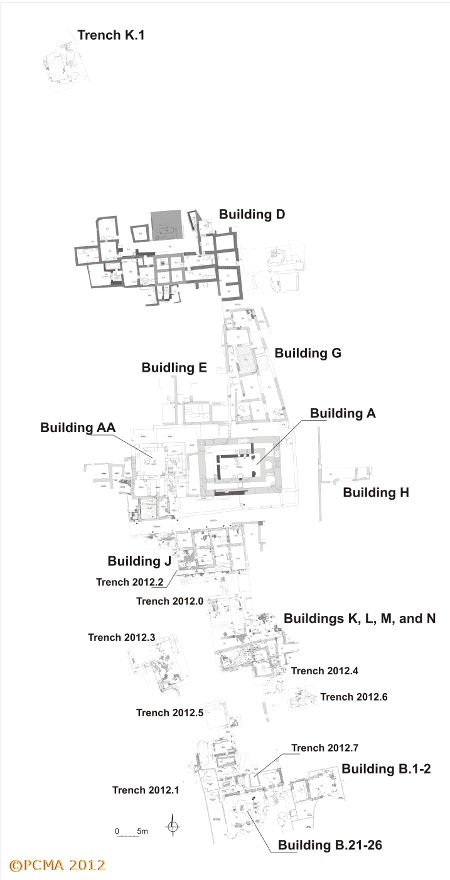
The industrial nature of this sector of the site is undoubted, as indicated by extant furnishings, such as the vat in Trench 2012.3 [Fig. 2, bottom left] or the small basement in Trench 2012.0 [Fig. 2, right], and tools recovered from the fill, for example, the massive wooden pestles (Nd.12.023 and Nd.12.114-115) [Fig. 5, left]. Pottery uncovered in the course of the excavations was also industrial in nature: it consisted mainly of locally produced amphorae (LRA.7), as well as imported storage containers from North Africa and Palestine. Together they paint a picture of the functioning of the market in Fayum in the 9th–10th century.
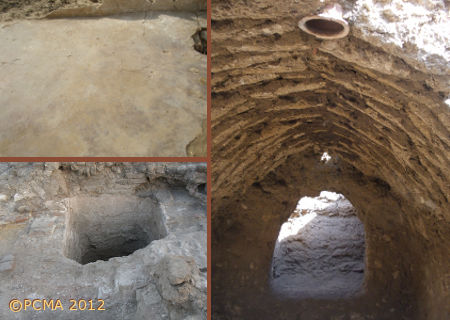
Meriting note is a huge Palestinian amphora bearing an Arabic inscription on the body. It is a kind of address: a man, most likely a Muslim, sent the amphora with contents to a monk residing in the monastery [Fig. 3].
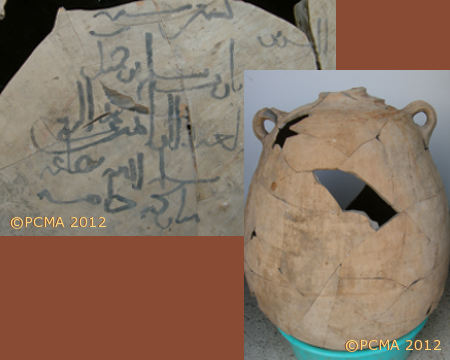
A clay jar with several finely preserved fish was discovered in trench 2012.3, next to a pair of much worn leather sandals. The fish (the species has yet to be identified) may have been caught in a nearby canal. Like many other items found inside the monastic architecture, the fish were left behind when the buildings were abandoned [Fig. 4].
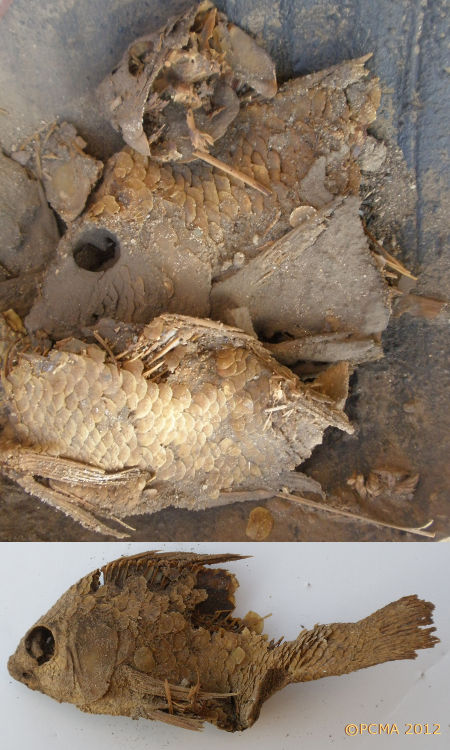
Finds included blown glass vessels [Fig. 5, bottom right], wooden objects, several texts on paper and parchment, fragmentarily preserved, written in both Coptic and Arabic [Fig. 5, top right]. The leather cover of a codex, Nd.12.021 (H. 34 cm; W. 23.5 cm), discovered in trench 2012.0 came undoubtedly from the monastery library [Fig. 6].
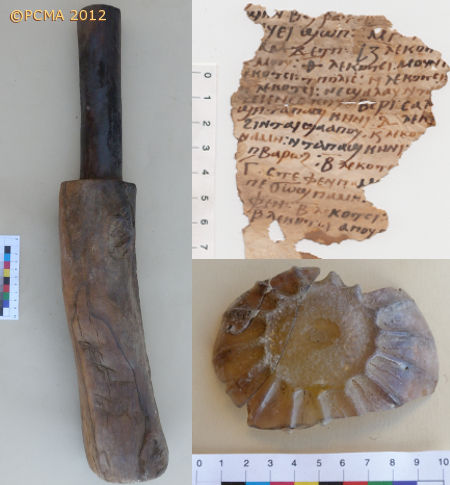
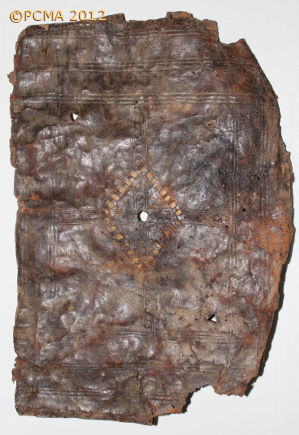
A basement 5 m square in area, covered with a fragmentarily preserved vault, was cleared in Trench 2012.7, located on the northern edge of the refuse dump. Niches suggest that it was a dwelling, but no doorway has been discovered so far [Fig. 7]. The bricks and building technique indicate a date in the 10th century, corroborated by the pottery from deposits constituting the fill of the room [Fig. 7, bottom right].
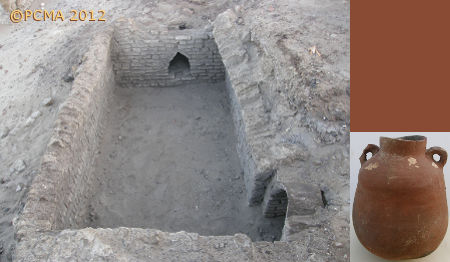
Conservation of metal objects
Objects made of copper and its alloys, silver, and iron from the excavations were subjected to conservation treatment by restorer Władysław Weker. Corrosion process had been slow in the dry conditions of the environment in which they were found. Some of the objects were covered with a thin layer of oxides resulting from slow oxidation of the surface in an arid climate. Others, like the ring Nd.02.276, required little more than a light cleaning and surface protection. In most cases, however, the surface was damaged or partly deformed by corrosion (e.g., iron nail (Nd.00.227) and bracelet of the same material (Nd.00.220) where the metal core was missing and the surface was substantially deformed). A number of objects, like a nail (Nd.93.109) [Fig. 13, left] and undefined copper-alloy object (Nd.09.557), had a well-preserved “fire patina”, that is, a layer of oxides due to exposure to high temperatures. The coat of oxides served as a protective layer thanks to which the finds were much better preserved.
Objects were cleaned mechanically with various scrapers, needles, rotating metal brush and fibreglass brush. To loosen the hard products of copper corrosion, a 10% solution of sodium versenate was used. Once the outer layer of corrosion was removed tests for active corrosion were done (in a sealed humid environment) without producing any positive results. The finds were subsequently dried, traces of grease and dirt were removed with acetone and the surfaces were protected with a layer of acrylic resin (PARALOID B-72). Before applying the protective layer, the finds made of copper and its alloys were immersed in a stabilising solution of sodium sesquicarbonate (Na2CO3 +NaHCO3).
A total of 34 metal finds were treated, including 17 iron objects, 15 artifacts made of copper and its alloys, and two silver finds. In the case of three objects: a silver ear-ring (Nd.99.110) [Fig. 8, right], an iron ornament of interconnected chain-links (Nd.00.64) and an iron rod (Nd.09.531), conservation should be continued in the forthcoming season.
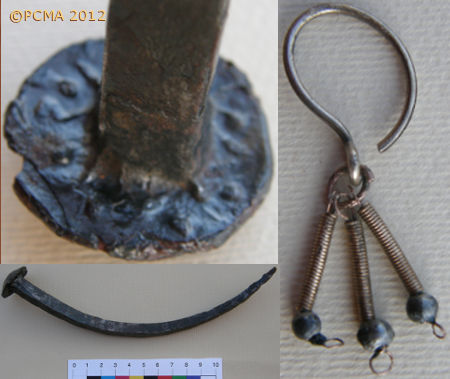
Study of coins
Dr. Gizela Helmecke from the Museum of Islamic Art in Berlin examined Umayyad, Abbasid and Fatimid coins (dinars and dirhams) uncovered to date in the monastic complex. The bulk of the material consisted of a hoard (see Newsletter 2009) found in 2009, which contained 80 complete coins and fragments of coins. Professional cleaning by the team’s metal restorer has enabled a more precise identification of many of these coins. Some dates, personal names and mint names, unclear in the preliminary stage of research on these fragments, were clarified. Several fragments were identified or corrected and, thus, placed in their correct historical context. Thirteen coins found in 2005 have also been restored and their inscriptions, previously not fully legible, read. Furthermore, the reading of the individual coins found during several campaigns, as well as of two Fatimid glass chips and two coin dies, was confirmed and some corrections were made. New photographic documentation in variable light was completed for all of the coins.
Study of mud stoppers
The mud-stoppers found in Naqlun were studied by Dr. Dorota Dzierzbicka from the University of Warsaw. One of the main objectives was the study of stamp impressions, identification and cataloguing of iconographic representations, as well as deciphering inscriptions and monograms. Fragmentary impressions of rims, necks, handles and shoulders of amphorae, which the stoppers once sealed, were documented. Based on the latter, a large group of the stoppers was associated with LRA 7 and LRA 5/6 amphorae dating from the 6th and 7th century. A preliminary investigation of the material from which the stoppers were made suggests that it originated in both alluvial and desert environments.
Acknowledgments
The Supreme Council of Antiquities is gratefully acknowledged for making every effort to ensure a safe and effective season. The hospitality of the Fayum Coptic monastic community and the personal involvement of Abuna Abraam in creating a proper environment for the mission’s work is greatly appreciated.
[Text: W. Godlewski]
